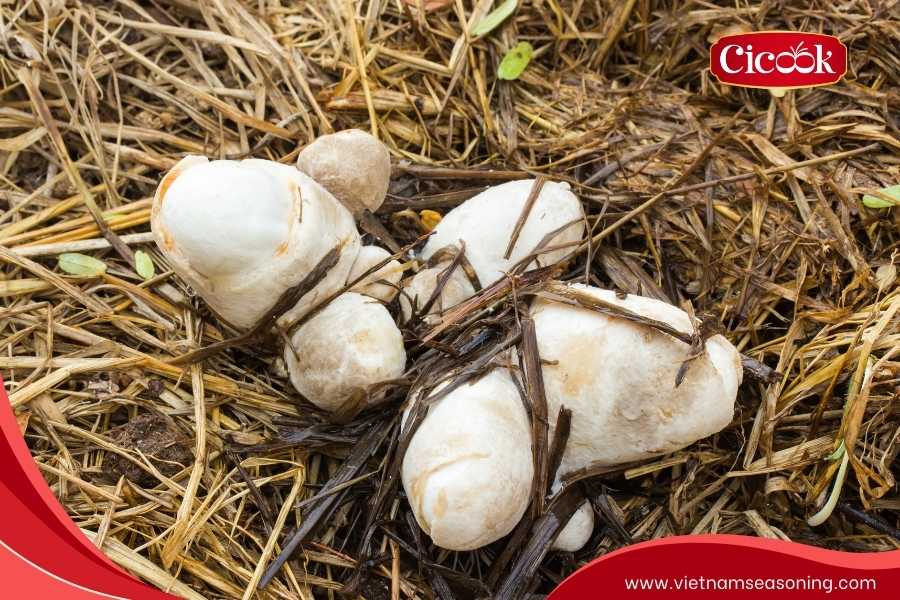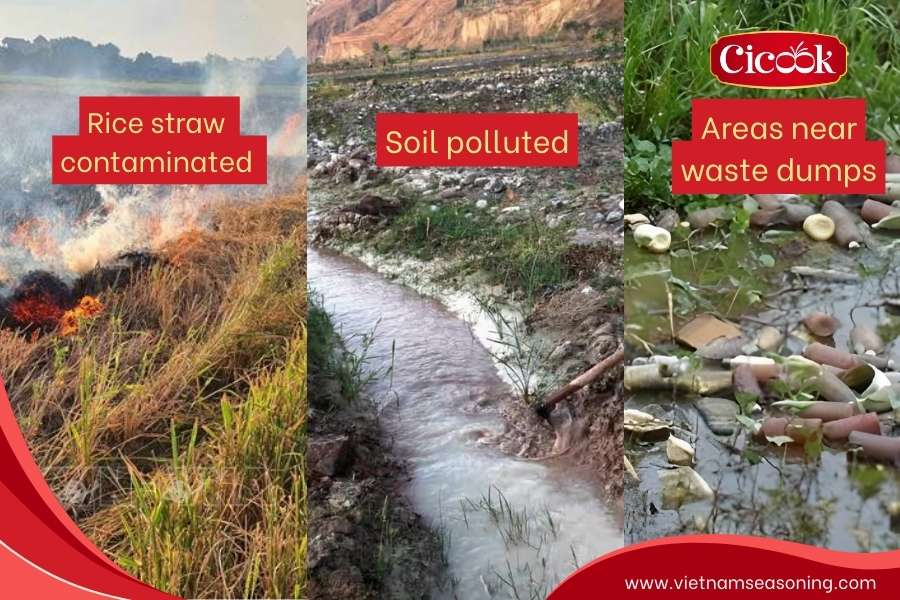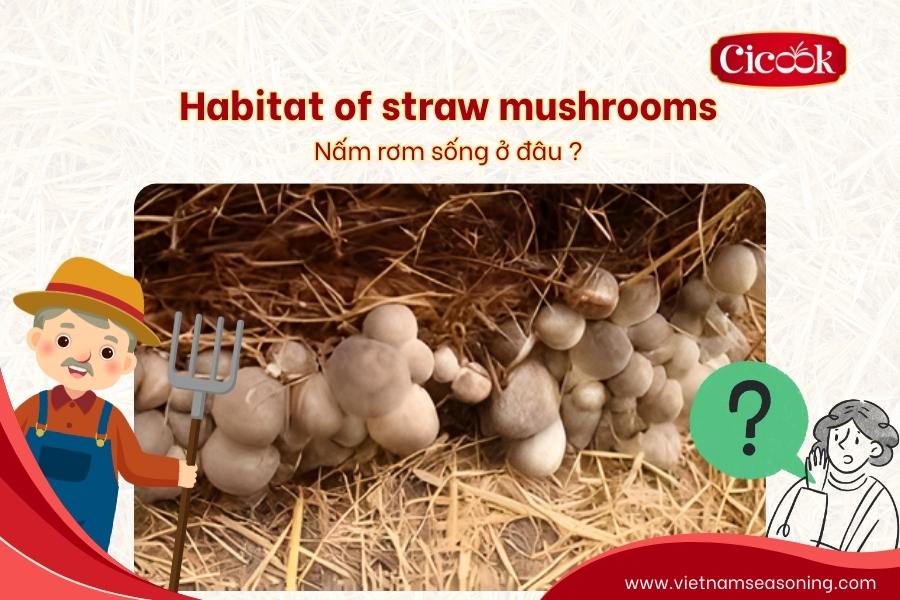Straw mushrooms thrive in warm, humid environments rich in organic matter. Their habitat strongly influences their nutritional value. Understanding where straw mushrooms live and the conditions they require helps you choose safe, high-quality ingredients for family meals and make informed decisions when selecting reliable, well-produced mushroom products.
1. Understanding the habitat of straw mushrooms: Natural environment and biological characteristics
Straw mushrooms are popular edible fungi that thrive in areas with warm, humid climates rich in organic matter, helping decompose decaying materials such as rice straw after harvest or rotting plant stems.

The structure of straw mushrooms has distinctive features with a rounded cap, white stem, and a volva (universal veil) wrapping around the mushroom base. Thanks to their high adaptability, straw mushrooms have been studied and widely cultivated by humans, helping provide a stable food source.
2. Ideal growing conditions for the straw mushroom habitat
The ideal habitat of straw mushrooms requires strict control of microclimatic factors to replicate suitable natural conditions:
- Temperature range: 25-35°C (77-95°F) for optimal development
- Air humidity: Maintained at 70-80%
- Substrate: Organic materials like rice straw, sugarcane bagasse, or sawdust
These stable environmental conditions are typically ensured by constructing enclosed mushroom houses with temperature and humidity control systems. The substrate provides essential nutrients while creating the breathable environment necessary for mycelium development and healthy fruiting body formation.

2.1. Optimal microclimate for each growth stage
Cultivating straw mushrooms requires flexible adjustment of microclimatic factors throughout each developmental phase. Strict control of these conditions optimizes yield and ensures quality at harvest.
|
Growth Stage |
Ideal Temperature |
Ideal Humidity |
Habitat Requirements |
|
1.Spawn Running |
30-32°C |
Substrate 65-75% |
Dark environment with moderate ventilation |
|
2.Mycelium Growth |
28-30°C |
Air 70-80% |
Lightly enclosed environment, avoid drafts |
|
3.Primordia Formation |
26-28°C |
Increased high humidity |
Stimulate pin formation; increase ventilation and light exposure |
|
4.Fruiting Body Development |
28-32°C |
High 80-90% |
Good ventilation to prevent CO₂ buildup and mold; light misting |
|
5. Harvest |
N/A |
Reduce watering |
Harvest when mushrooms are button-shaped before cap opens; avoid heavy watering before harvest |
2.2. Substrate selection: Research from Vietnam agricultural science institute
According to research from the Vietnam Agricultural Science Institute, rice straw is the most common and optimal substrate for the habitat of straw mushrooms. This material not only provides sufficient nutrients for mushroom development but also creates a breathable environment-an essential condition for healthy mycelium growth and fruiting body formation.
Alternative substrates like sugarcane bagasse and sawdust offer flexible options. However, regardless of the substrate material used, it must be clean, nutrient-rich, and undergo proper sterilization procedures before inoculation.
3. How habitat affects straw mushroom quality: Natural vs Cultivated
The habitat of straw mushrooms greatly shapes their nutrition and flavor. Wild varieties often contain more calcium, iron, zinc, and selenium due to mineral-rich soil and growth on decomposing organic matter, where symbiotic microorganisms enhance nutrient absorption, giving them a firmer texture and richer taste.
The slower growth process in natural habitats results in mushrooms with firmer texture and more intense flavor. Conversely, cultivated straw mushrooms grown in controlled environments develop faster, with slightly reduced nutritional content, texture, and flavor. However, the controlled cultivation habitat ensures better food safety standards for consumers.
|
Nutritional Component (per 100g) |
Natural Straw Mushrooms |
Cultivated Straw Mushrooms |
|
Energy (kcal) |
30-35 |
28-32 |
|
Protein (g) |
3.5-4.5 |
3.0-4.0 |
|
Fat (g) |
0.5-1.0 |
0.3-0.8 |
|
Calcium (mg) |
8-12 |
6-10 |
|
Selenium (μg) |
2.5-3.5 |
1.8-2.8 |
|
Vitamin C (mg) |
3.5-5.0 |
3.0-4.5 |
4. Poisoning risks: Which habitats carry higher toxin risk?
The habitat of straw mushrooms in uncontrolled wild environments poses higher poisoning risks compared to cultivated varieties, requiring special caution when foraging. Wild mushroom collection demands extreme care as mushrooms can accumulate toxic substances from their surrounding environment, directly endangering health.
Since straw mushrooms absorb substances from their growing substrate, mushrooms developing in polluted areas are more susceptible to contamination. Locations to avoid when foraging for natural straw mushrooms include:
- Rice straw contaminated with pesticides or herbicides
- Soil polluted with heavy metals like lead, mercury, or cadmium
- Areas near waste dumps or industrial wastewater

Additionally, the habitat of straw mushrooms with excessively high humidity poses mold contamination risks:
- Aspergillus mold can develop, producing aflatoxin, a dangerous carcinogenic compound
- Mushrooms growing on soil with toxic bacteria like Clostridium botulinum may contain botulinum toxin, causing dangerous paralysis
Due to these risks, consumers should prioritize straw mushrooms cultivated in controlled, clean, and safe habitats. At Cicook, the habitat of straw mushrooms follows clean farming practices with organic-oriented models, using chemical-free substrates with strict control over water sources, humidity, and microbiology.
Consequently, Cicook mushroom products retain natural nutritional content while minimizing toxin contamination risks, providing peace of mind for families and F&B establishments in daily use.
5. Frequently asked questions
- What are the benefits of straw mushrooms?
Straw mushrooms are rich in protein, B vitamins, and minerals like calcium and selenium. They help boost immunity, support digestion, and are suitable for daily meals.
- Where can I buy safe straw mushrooms?
Purchase from clean food suppliers that meet international safety standards like Cicook, which applies clean, organic-oriented farming models ensuring mushrooms are free from harmful chemicals or microorganisms.
- How do I distinguish straw mushrooms from poisonous mushrooms?
Straw mushrooms have rounded button shapes, gray or light brown color, white stems, and a mild fragrance. Poisonous mushrooms typically have bright colors, abnormally shiny caps, or distinctive rings/gills under the stem.
- Where do wild straw mushrooms grow naturally?
Natural straw mushrooms typically grow on decomposing rice straw after harvest in warm, humid climates. However, avoid polluted areas or straw treated with chemicals as they easily carry toxins.
